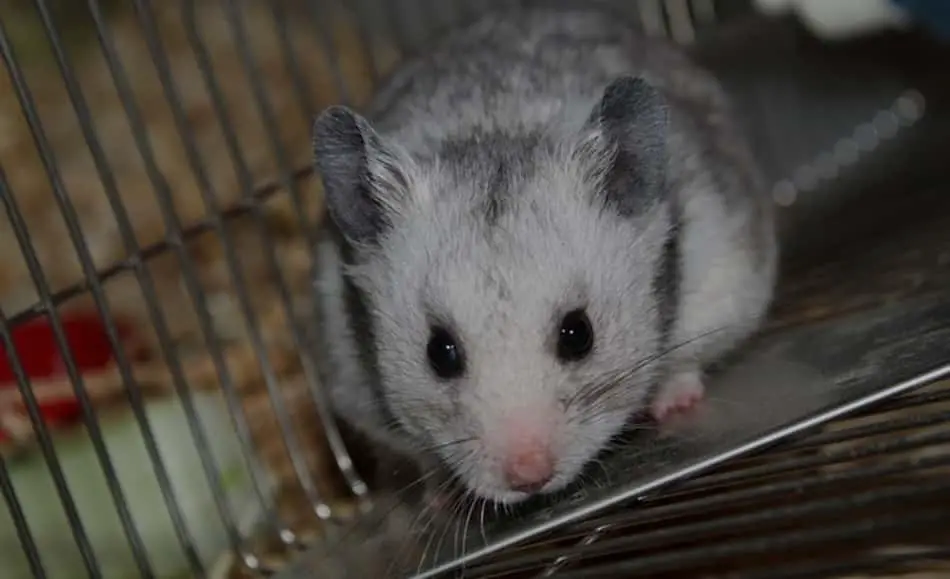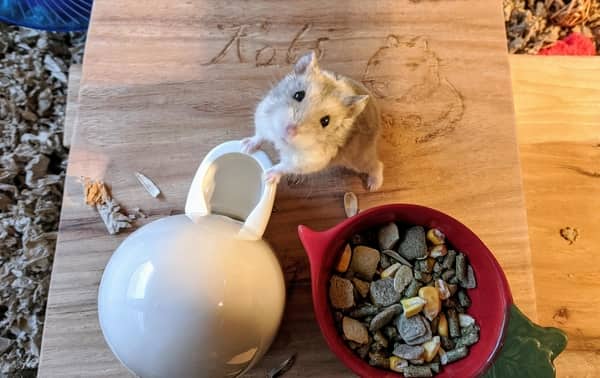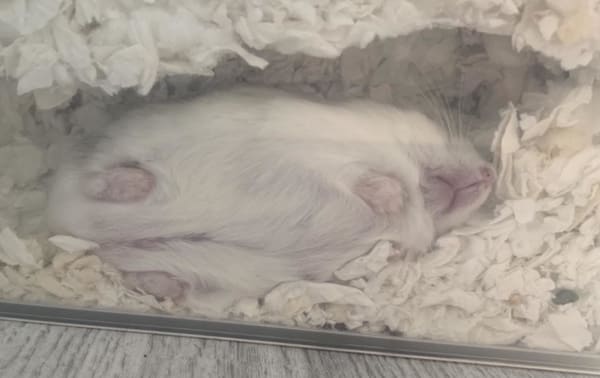It’s no secret that water is essential for pretty much every function of your hamster’s body. But exactly how important is it? And how significant is the quality of the water you provide for your pet? These are great questions with answers that may surprise you.
So, how often should you change your hamster’s water? Generally, you should clean out their dishes and offer fresh water every day. However, the material and design of your water dish or dispenser can come into play.
This article will give you a step-by-step breakdown of all the factors that can affect your hamster’s water quality and help you determine what water-changing routine will be best for your situation. We’ll cover water dish options, water temperature, and what happens when water sits unchanged. Finally, we’ll touch on a few diseases and health issues related to infrequent water changes and how you can prevent them.
Why Water Needs Changed Frequently
An uncovered dish full of water is an ideal environment for the growth of all kinds of germs and bacteria. The water may also leach elements from the container it’s in and take on unpleasant tastes and smells from the air it absorbs.

That Slimy Coating
You know that icky slimy coating that forms in a pet’s water bowl when it hasn’t been washed in a while? That’s called a biofilm, and it’s a bacterial secretion. Bacteria in your pet’s bowl creates this slime to glue itself to the side of the bowl where it can live and multiply.
Is that as disgusting as it sounds? Oh, yeah. All that bacteria can cause a multitude of health problems for your pet AND for you! Additionally, while you may not notice a stench, your hamster’s sense of smell is at least 14 times more sensitive than yours, and to them the bacteria-filled coating really stinks.
Completely emptying, rinsing and refilling your pet’s bowl daily will increase the amount of time it takes for a biofilm to form, but it won’t keep it from forming at all. To completely avoid this gross build-up, you’ll need to thoroughly wash your hamster’s water bowl on a regular basis.
Multiplying Contaminants
How does that bacteria get into your pet’s bowl anyway? There are plenty of ways this happens. Some will come directly from your hamster’s mouth when it takes a drink. Others may have been picked up on its whiskers or fur from other areas of the cage or house.
Contaminants can also enter the water through the air or from bedding or fecal waste getting into the water. Hamsters are constantly digging and scratching around, making this a common occurrence if you provide water in an open bowl. If water is left sitting long enough, bacteria will begin to grow even if nothing has noticeably contaminated it.
Once bacteria, germs, and other contaminants have entered the water, they will multiply rapidly. Almost all microorganisms thrive in a wet, room-temperature environment.
Flattening or Change in Taste
Finally, water should be regularly changed because after it has sat out for a day or two, it has a noticeably stale or flat taste. This is a result of carbon dioxide from the air mixing with the water and changing its pH. While this minor change won’t hurt your hamster, the water’s off taste may discourage it from drinking as much as it should to maintain optimal health.
Other Reasons to Change Water Frequently
Along with the more obvious factors like bacteria growth, odor, and contamination, there are a couple less often discussed reasons for changing your hamster’s water frequently—preferably every day.

Do Hamsters Need a Water Bottle?
Yes, hamsters do need a water bottle for proper hydration. Providing a water bottle is crucial as it helps ensure a clean and easily accessible source of water for your hamster. Water bottles are preferred over bowls as they prevent bedding material and debris from contaminating the water, reducing the risk of bacterial growth and potential health issues.
The sipper tube attached to the water bottle allows hamsters to drink without getting their bedding wet. It’s essential to regularly check and refill the water bottle to guarantee a continuous supply of fresh water. This simple yet vital accessory contributes significantly to the overall well-being of your pet hamster, ensuring they stay hydrated and healthy.
Open Dish or Water Bottle
The argument for replacing the water in an open dish daily includes all of the issues we’ve discussed above. Water dishes are especially prone to contamination and bacteria growth. There’s simply no good way to be absolutely sure that bedding, fecal matter, or germs don’t end up in an open dish.
Water bottles are less likely to be contaminated in this way. However, there are still good reasons to change the water in a water bottle every one to two days. First, germs can still enter the water or be spread between hamsters when they lick the water bottle’s dripper.
Secondly, water bottles are prone to clogging if they’re not regularly rinsed out. They can also create a vacuum as they’re emptied that stops allowing water out.
Water Dish and Bottle Material
Water dishes and water bottles for hamsters may be made of plastic, stainless steel, porcelain, or glass. The material your hamster’s water dispenser is made of may help you determine how frequently it should be changed.
When it comes to most sanitary and least likely to need changed, plastic containers are at the bottom of the list. These dishes easily grow algae and bacteria. They can also quickly affect the taste of the water, decreasing your hamster’s desire for it. Even worse, plastic dishes and bottles may release small amounts of dangerous elements into your hamster’s water, especially if they get warm.
Dishes or bottles with a lot of crooks and crannies will also need washed more frequently as bacteria and algae love to build up in these areas.
Keeping Your Hamster Hydrated
Finally, changing your hamster’s water frequently will help make sure it stays fully hydrated and healthy. Your hamster is more likely to drink fresh, room temperature water than water that is stale, dirty, too cold, or too warm.
You’ll also be able to keep a closer eye on your hamster’s water intake if you change its water frequently. You won’t have to factor in evaporation or spillage and should quickly be able to notice if more or less water is being consumed than normal.
Best Water Changing Schedule
The best way to be sure you are changing your hamster’s water frequently enough is to have a regular routine. What this routine looks like from day to day will depend on how you choose to offer your hamster’s water supply. Water that has become contaminated should be changed immediately, no matter how recently it was fresh.
Routine for Open Dishes
Open water dishes should be changed every day. The old water should be entirely emptied, and the dish should be washed in soapy water or with a mix of water and vinegar. Unless otherwise instructed by a veterinarian for some reason, avoid using any cleaning solutions stronger than a basic dish soap or an occasional dash of bleach, and thoroughly rinse the dish after washing it.
Alternatively, you can keep an extra set of water dishes and run one set through the dishwasher each day.
Routine for Water Bottles
Water bottles should at least be checked every day. Make sure the water bottle has plenty of water in it and is releasing water when the ball at the end of the dripper is tapped. Approximately every three days to a week, the water bottle should be emptied, washed, and refilled with fresh water. Make sure to wash the dripper as well and check for clogging.
Why Clean, Fresh Water Is So Important
Did you know that your hamster is made up about 65% water? This is why hydration is so important. It keeps every part of the body functioning normally and at its full capacity. Water helps your hamster digest its food and eliminate waste regularly. It keeps its organs, blood, eyes, skin, and fur healthy and provides a cushion for its delicate internal tissues, bones, and nerves.
Signs of Dehydration
As long as you are keeping your hamster’s bowl or water bottle full of fresh, clean water, you shouldn’t have to worry about dehydration, but it’s good to know the signs in case your pet has fallen ill or is having difficulty drinking for some reason.
- Little or no urine or fecal matter
- Lethargy or depression
- Sunken eyes
- Dry skin
- Dull, ruffled fur
Diseases Connected to Old or Dirty Water
The quality of the water you offer is just as important as the water itself. As we’ve seen, bacteria can quickly build up and be spread by a contaminated water dish.
One of the most common diseases caused by dirty water is periodontal disease, which is a nasty infection of your hamster’s gums. Dirty water can also be the cause of various staph infections, salmonella, candida, E. coli, and gastritis, to name a few.
Urinary tract infections and kidney disease can also be traced back to bad water or dehydration due to your hamster avoiding water that is smelly or contaminated.
Conclusion
Fresh, clean water is essential to your hamster’s health, and should always be available. However often you need to change the water in its dish or bottle to make this happen, that’s how often the water should be getting changed. Keep in mind that even though you may not see or smell the microorganisms multiplying in water that is a few days old, they’re still there!



